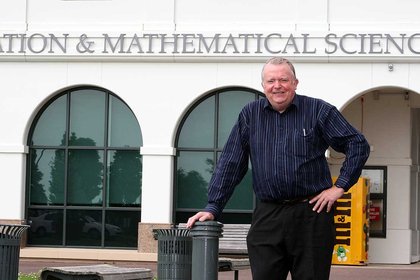
Professor Emeritus Graeme Wake.
It is widely accepted that the Global Financial Crisis in 2007 was the result of abuse of the financial markets, but could it all have been avoided by with an adjustment to a 20-year-old economic model?
The Black-Scholes model was awarded a Nobel Prize in economics for developing a way to price a contract before it had ended, but years later it would find itself cited as the cause of the 2007 crisis and other events like Black Monday in 1987.
Massey University’s Professor Emeritus Graeme Wake and Professor Jeong-Hoon Kim from Yonsei University in South Korea have revisited the model and re-formulated it to better cope with today’s markets.
Professor Wake says companies were using the model to assess risk in their trading, but nobody considered its limitations.
“When the model was developed in 1973, it was adequate for the financial markets of the time and underpinned massive economic growth – but it was never designed to cope with the increased sophistication of the marketplace and failed to predict the effects on the world’s financial markets if an event like 2007 were to occur.”
Professor Wake says that when the model was introduced, it allowed the practice of option trading to become a profitable and successful industry.
“It provided financial markets with a way to price a financial contract when it still had time to run so it could be bought and sold. This was known as a derivative and it served a useful purpose in the right situation.”
For example, an options trader might offer a five-year steel contract expected to make $5 million to another trader in the fourth year of the contract for $3 million. The trader uses software, which takes the data available and puts it through complex mathematical formulas to calculate the sale price; other traders use similar software to assess whether money can be made from the deal or not.
“The buyer or the seller makes money on whether it performs better or worse than the model predicted. But the world’s financial institutions got clever and used the model to create a money-making instrument. People started buying and selling the derivatives in their own right, effectively investing in the investments, and causing a short-term boom that would lead the world economy into a crash.”
The revised model
The researchers’ new procedure will have a greater capacity for coping with more complex scenarios and provide calculations allow the model to better predict catastrophic events and their effects. Their model will incorporate data sets after a sudden change of events to predict the waves that result from big events like the 2007 crash. The model will then be able to take the predicted waves into account when calculating risk.
The pair now intend to test their model by feeding in historical data – for example the data available before the 1987 crash – to see if the model effectively predicts the waves that followed. If the revision proves accurate, then software can be developed to run the complex formulas.
“It’s a mathematically interesting and challenging problem which might turn out to be a financially meaningful correction to the classical model,” Professor Kim says.
“The difference between the classical Black-Scholes equation and the new system of equations is that the new one is a pair of linked equations for both the price of an option and the hedging ratio, while the former is just one equation for price of the option. Though the earlier one is simpler, it cannot explain the more complex operations we see today."
“It is not all done and dusted though. A lot more work and effort is needed to ensure the new procedure is accepted by providers of software based on the Black-Scholes equation. The model is a sophisticated mathematical algorithm and as such needs more analysis and testing.”